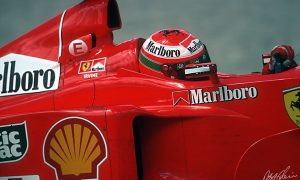
RED BULL TRYING TO LEAVE RIVALS IN ITS WAKE
A trio of strakes has been added to the rear wing’s endplate on the Red Bull RB12. What are they here for?
These help guide the airflow upwards; otherwise the air tends to dip (see yellow arrows on the drawing above). These aero elements contribute to the airflow deflection that happens at the rear of any F1 car.
Basically, the air flowing below the rear wing (here shown by the blue arrows) goes upwards as it follows the outline of the wing. This ‘upwash effect’ creates a low-pressure wake, which is located above another low-pressure area generated in the wake of the diffuser (see white arrows).
These two adjacent zones are interacting with each other as follows: the wing-induced low-pressure air sucks the diffuser-created wake upwards. This ultimately allows the diffuser to extract more air from underneath the car, which results in an increase in downforce.
Seen for the first time on a Red Bull machine, these strakes feature on all other F1 cars… save the Mercedes. Instead, the W07 endplates have been shaped and hollowed out so as to channel the airflow upwards.







